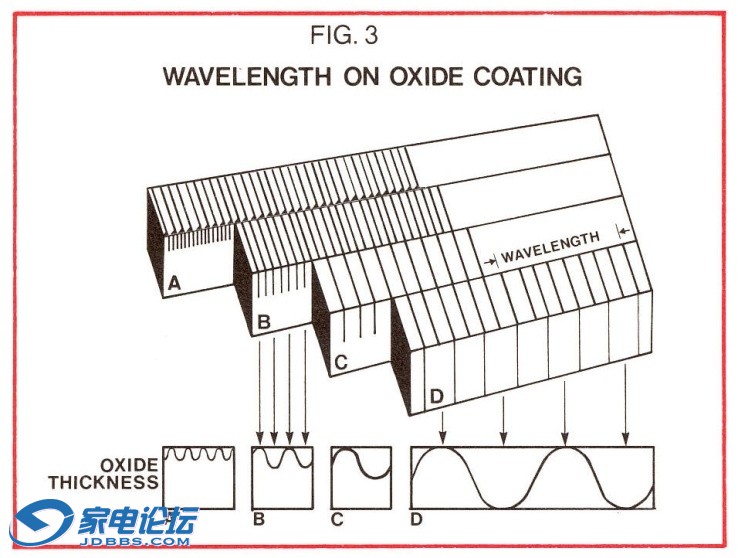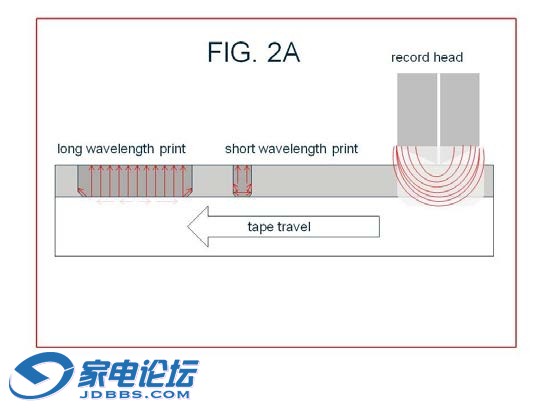马上注册 家电论坛,众多有奖活动等你来参与!
您需要 登录 才可以下载或查看,没有账号?注册

x
本帖最后由 全中文说明书 于 2015-11-24 09:14 编辑
译者注:本文为德国BASF公司官方发布的公告文献PDF文件的翻译,其中详细描述了盒式磁带,开盘机磁带因为微分效应和高频损耗相互作用产生的天然物理特性和相对应EQ均衡播放原理的形成,以及几种材料磁带的先后发明过程,文章最末尾介绍了chromium dioxide120磁带的由来和技术成因。本文第二楼是英文全文。
BASF公司的这篇文档详细披露了在盒式磁带中,历史上铬磁带发展的三个阶段,三种铬带的研制过程及性能。也可从中看出第一种和第三种铬带使用120uS,而第二种铬带使用70uS均衡的具体原因。由此可以排除流行于市面的商业预录磁带中标识有chromium dioxide120,CrO2 120之类似标识的磁带,是直接采用70uS的“二类带基”的可能性。

技术公告4

在1819年一次演讲中,汉斯·克里斯蒂安·奥斯特公布了他出乎意料的发现,在导体内通过电流,会在导线周围产生磁铁般作用。在1831年10月,法拉第发现相反的效果:在导线组成的线圈旁边移动磁体会在线圈中产生电流;更快地移动磁铁,就会产生更大的电流。这两项发现导致了电力的发展作为能量的介质。今天,我们通过水或者蒸气的压力带动连接着巨大的磁铁的转动轴发电。轴和磁铁被导线制成的线圈包围。如果电机被输入电流,电流进入电机的线圈,通过轴上的磁铁作用,可以带动钻头,转动转盘。
法拉第也发现了应用磁带来录制和播放,磁头实际上是内部缠绕铁丝的电磁铁。当音乐被转换成电流,电流被发送到磁头,去产生磁铁的磁性印刷图案一样弄到磁带上。
当录音磁带在磁头上经过,磁带上的磁性印记在磁头产生一个电流经过放大器放大后馈送给扬声器。磁头感应出的电流(它的输出),并不是依据在磁带上的磁信号的强度,电流强度取决于在磁通水平的变化率,或者,换言之,就象快速地将磁性印记移动通过磁头,就如同在法拉第线圈一样。录制好的磁带不移动经过磁头,磁头是没有感应信号的。因为高频率具备比低频率更强的印记(参照图3)它们具备有更大的变化速率(它们看起来可以等同“移动更快”)因此,它们具有更大的输出幅度。在电压方面,输出量的增加是以每倍频程6分贝----也就相当于每次频率增加两倍输出幅度也增加两倍。为了补偿这个增大的输出量,(图1A)一个磁带录音机的重放部分具有内置的斜率衰减电路(图1B),使得增加的和衰减的部分抵消“均衡”成为一个平坦的频率响应(图1C)。这样,均衡祢补了输出的差异而使它们各频段相等。然而,随着频率的增加,并且磁印记(波长)之间的距离变短,高频损耗等因素,再加上磁带速度过慢,过宽的播放磁头缝隙,这些磁带上的限制导致6分贝/倍频输出的增加量停止下来,并且开始下降。为了解决这个问题,在衰减的斜率(B)下陷特定的频率点,使得高频自然输出升高祢补了高频的损失。

这第一种氧化铁磁带上造成的每倍频6分贝的增加量的消失位置,位于一个相对低的频率,是因为盒式磁带的磁带移动速度远远低于开盘式录音机。输出增量曲线开始转向下降到3分贝的位置就是1326.3HZ的位置,因此,“均衡”衰减(B)下陷点在这个频率。在电子工程方面,这个转折点是用“120微秒时间常数”(uS微秒,百万分之一秒)来表示。 造成输出衰减的主要原因见图,1A是间隙损耗,这是由于表面凹凸损耗和磁性涂层的厚度共同原因,虽然短的波长产生的频率越来越高,因此,产生了更大的电流在播放磁头,当磁头开始很难读取它们的时候,短波长信号输出就开始衰落,因为磁带的粗糙度也因为它们持有的磁性能量的额度不足以能够到达磁头工作缝隙,因为与磁场距离的增加导致磁强度按指数滑落,因此由于表面粗糙造成的即便是轻微的磁带离开磁头的运动将会导致输出的损耗,而这些损耗在短波长中最明显。改进效果是最显著的,就是磁带制造商已经能够通过在生产过程中硬性碾压和抛光来增加一些磁带的制剂材料的高频特性,而不必诉诸去改变氧化物的矫顽力。

输出的损耗是由于磁带的厚度这种其它形式的间隙损耗存在,短波的磁场输出更加靠近磁带的表面,因为短波的磁性图案印记要录到涂层更深处,就犹如录音磁头离开录音区域去改变磁性图案印记的方向一样困难。虽然这也适用与长波长,有一个“正确排列”非常大的区域的磁通,长波长相比短波长,可以产生更大的磁性图案印记。(图2A)。在涂层深处改变磁印记图案容易造成相互抵消,直到他们更接近于表面。(录音过程中减小偏磁使得更多短波能量接近表面并且减小短波长由于自我擦除造成的损耗。但是偏磁的减小也降低了磁化渗透入涂层导致了长波的低输出/高失真,因为被适当磁化的涂料更少了,增加偏磁能磁化更多的涂料,到了一定程度,但是也能驱使短波长打印到更深的涂层并且也增加了自擦除,降低了高频输出。)更薄的涂层提高了高频输出,但是低频输出会损失。典型盒式磁带的标准厚度的涂层也意味着播放磁头失去解决短波由于损耗点开始3分贝之后在1326.3HZ位置间隙损耗的能力,这就是为什么下降均衡在图1B是陷波在这个位置的原因。

二氧化铬磁带的发明显著改进盒式磁带的高频响应,是一个全新的氧化物磁带,高频效能相比铁氧化物材料更高超。氧化物的粒子均匀特性允许磁带的表面更加平滑,并且它更高的矫顽力允许它承受更高电平的高频能量。在其推出的同时,然而,这磁带作为一种音乐介质得到最大的抱怨就是它的磁带嘶嘶声。 磁带工程师决定牺牲较高的输出或者说是铬材料的“SOL”(饱和输出电平)以便减少磁带的嘶嘶声。他们决定移动CrO2材料过渡点到一个更高的频率2.273.6HZ,或者也可称为70-uS EQ。70-uS的时间常数是有利的,因为它允许6分贝/倍频程的斜率(B)的继续增长,并且对于影响来说,“补偿”较少的高频(图2);并且较少的高频补偿意味着更少的磁带嘶嘶声被被同时提升。在盒式磁带主要听觉差别不在于高偏磁或者普通偏磁,而是在于70或120微秒均衡的改变:70-uS EQ将始终发生4.5分贝以下的磁带嘶嘶声。二氧化铬,和二氧化铬相当的,铁铬双层,和金属颗粒磁带都是使用70-uS播放EQ。

还有一个盒式磁带播放的时间常数是除了120uS和70uS之外未被广为人知:3180uS(50HZ过渡点)。提高最低的低频频率,以至可能出现嗡嗡声或者低频噪音这样的问题,低于50赫兹的频率在播放的时候略微下滑。为了祢补这方面的滑落,在录音过程中录音EQ电路给这些频率以录音补偿使之在播放的时候均衡。但是一些制造商放弃3180-uS时间常数标准,因为他们感觉为了更好的低频响应设计的新型磁头是会受到这个时间常数的限制的。一台有3180-uS EQ的卡座录制的磁带在没有这个EQ的卡座上播放会产生太多的低音,除非音调控制可以把它降低到一定的程度。
播放均衡是制订了标准化的,所以在任何一台机器上录制的磁带将会在所有的机器上播放出相同的声音,因为所有的机器拥有相同的精确的播放EQ电路。由于磁头的种类,电路,和磁带制剂材料不同,任何方面的调整是用来形成录音中的均衡,或者使用特定的磁带在特定的录音机中进行“预加重”的。这些调整是为了形成录音EQ,这样,所有的卡座依据标准的播放EQ电路,在播放中的频率响应就是平坦的了。(图3)。在录音前,所有的卡座使用录音EQ的一些定量给高频以提升,因为高频的损耗不能简单通过使用播放EQ电路来降低斜率的方法来足够补偿。在录音之前提升高频信号再搭配上播放EQ也防止了增加磁带的嘶嘶声,但是录音EQ一定不能这么大幅度,因为提升过高会导致由于磁带的超载造成的明显失真或者饱和。这样,尽管播放EQ电路是所有机器上的标准,每个机器有个可调节的录音EQ用来保证在标准的播放均衡器中频率响应的平坦。

开盘磁带机也使用均衡,并且更快的磁带速度意味着更少的频率急剧变化。然而,同时出现的情况是,因为磁带速度的各种品种,因为不同的标准存在----NAB,DIN,IEC,和CCIR。大多数美国和日本的开盘卡座符合NAB标准,有些类似与那些盒式磁带卡座。NAB和其它的标准,欧洲的标准主要的区别在于NAB允许播放中的6分贝/每倍频斜率继续到更高的过渡频率,以降低更多的磁带嘶嘶声,并且为了防止嗡嗡声问题和低频噪音,播放中不提升那么多低音量。NAB标准要求3¾,7½,每秒15英寸速度(ips)的磁带在3180-uS EQ的低频响应滑落;高频时间常数3¾磁带是90uS(1.768HZ)。7½ ,15 IPS磁带是50uS(3.183Hz)。At 30 IPS没有低频衰减,17.5uS(9.095Hz)是其高频EQ。
欧洲标准,DIN(德国),IEC(国际),或者是COIA(法国)使用不同的时间常数(图4). 3 ¾ IPS磁带采用了NAB相同的速度。但是其它所有带速的磁带是没有低音滚降的。7½磁带的高频时间常数是70uS(2274Hz),15iPS磁带是35uS(4574Hz)。
一些专业机的设计使得NAB或者IEC的播放EQ其中一个选择是可采用的。一个开盘录音机上NAB EQ的运用是在录音均衡上使用一个低音补偿提升播放中的3180uS的滚降损失部分。NAB时间常数也比IEC时间常数要求更多的高频录音预加重,因为高频的翻转点或者说是过渡点发生在更高的频率可以避免更多的嘶嘶声(70uS的时间常数盒带相比120uS的来说有小了4.5分贝的低噪音)。
缺陷就是额外的预加重补偿促使高频接近失真或者饱和点,在7 ½ips磁带中,相比333HZ音调电平,14000Hz音调将会提升大约6到8分贝那么高幅度。3 ¾ ips磁带是10-12分贝;并且同样在盒带速度下相当于16-20分贝提升量。通常音乐中包含大约相比中频小40分贝的这么高频率,但是现场音乐和高质量的光盘可以包含更大的高频能量,当这个更大的高频能量得到一个额外的16-20分贝的补偿,它就有可能让磁带饱和。
6分贝/倍频的斜率转换到不太陡峭的曲线变化,是通过磁带卡座内置的电子阻容网络决定的,转折频率有以下公式决定。
其中T是时间常数,以微秒表示,并且时间常数值是一个整数比如70或者120。时间常数自己取决于RC网络中的电阻乘以电容的数值。比如,10000欧电阻乘以一个0.007微法电容将要得到一个时间常数: 10,000 ohms x (7 x10 farads) = 70 x 106 seconds = 70 μs
其次微秒所指的时间,是当所有其它数值相互抵消的时候,电阻乘以电容的时间单位。
在1970年初期杜比B降噪很明显将变成高保真盒式录音机的标准的时候,BASF公司的工程师非常后悔移动到70-uS均衡,因为杜比NR降噪可以降低磁带噪音10分贝。如果二氧化铬磁带有保留在120-uS均衡,并且让杜比NR解决嘶嘶声的话,二氧化铬磁带将拿回为了降低嘶嘶声而牺牲掉的4.5分贝的SOL电平。
当二氧化铬磁带应用在高速磁带复制机上的时候给了自身一个机会,BASF公司确信A&M唱片公司发行警察乐队的“Synchronicity”专辑在播放均衡在120uS EQ的盒式磁带上,BASF铬带的无与伦比的低噪音通过附加杜比B降噪和增加了SOL电平给予磁带的大动态范围使它非常接近TYPE IV金属磁带使用杜比NR时候的效果。
|  京公网安备 11010602010207号
( 京ICP证041102号,京ICP备09075138号-9 )
京公网安备 11010602010207号
( 京ICP证041102号,京ICP备09075138号-9 )